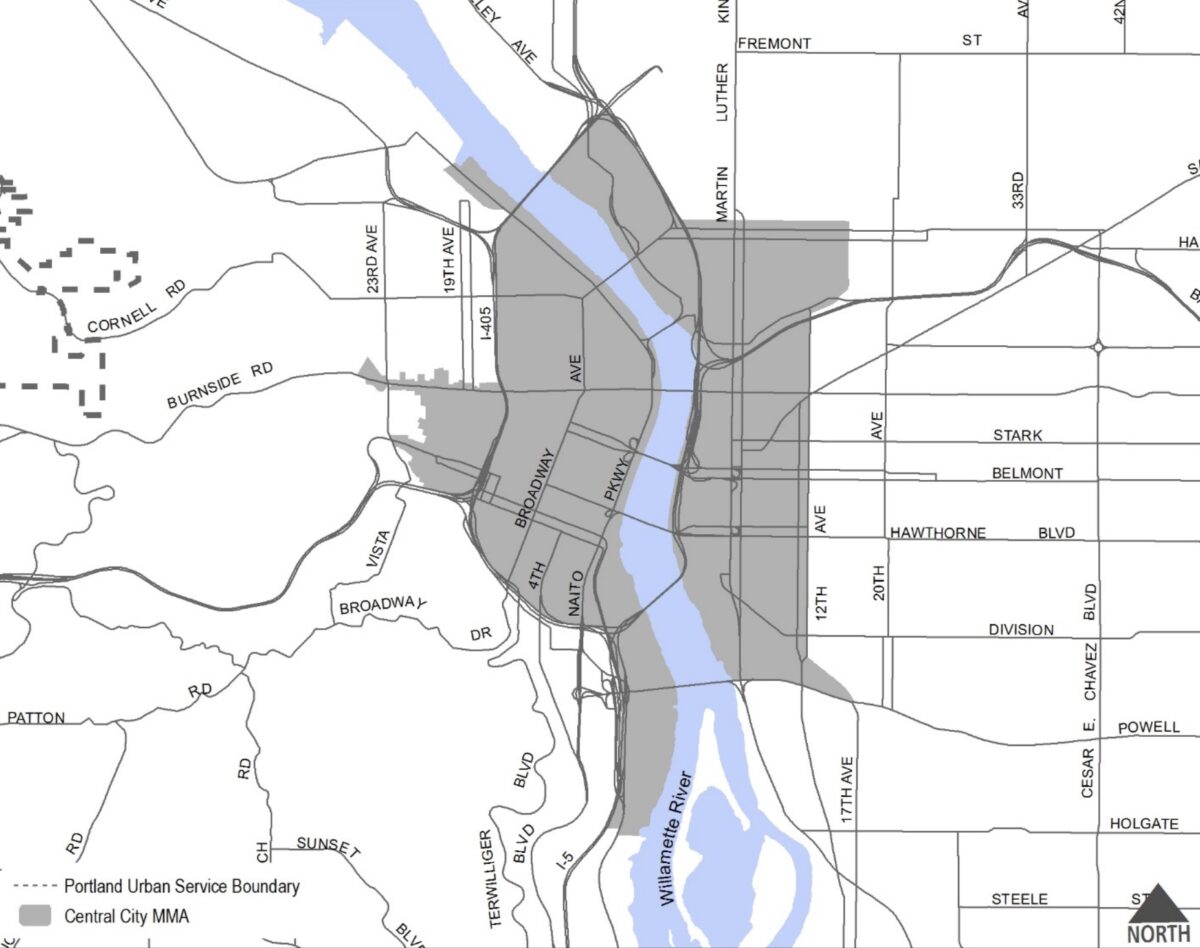 Central City Multimodal Mixed-use Area boundary. (Source: City of Portland)
Central City Multimodal Mixed-use Area boundary. (Source: City of Portland)
This seems to imply that City would be unable to provide ‘safer and greater’ conditions for bicycling without this project. This is untrue.
The list of people who have criticized the Oregon Department of Transportation’s latest design proposal for their I-5 Rose Quarter project includes some obvious names (like anti-highway advocacy group No More Freeways PDX) and some more unexpected ones (like the entire Trail Blazers organization). Members of the Portland bicycle and pedestrian advisory committees have also spoken out against the design, which they think will create worse conditions for people biking and walking in and around the Rose Quarter.
It’s one thing for activists and other stakeholders to make strong public statements against a megaproject. It’s another thing entirely when concerns come from another government agency — especially one that’s an official project partner.
Last week we shared what former PBOT Director Chris Warner had to say about the project as part of his official comments on ODOT’s supplemental environmental analysis (SEA, a document required by the federal government as part of the NEPA process). Warner’s statements were backed up by 135 comments from 13 different city staff members, 44 of which came from longtime PBOT Bicycle Coordinator Roger Geller.
We highly recommend taking a closer look at all the comments (one PBOT engineer calls the new southbound ramp a potential “fatal flaw” and the word “misleading” is used three times) — but for now I want to focus on Geller’s and on one thread in particular.
Geller’s comments reveal an interesting (and growing?) tension between ODOT and PBOT about something called the Central City Multimodal Mixed Use Area (MMA). If you came to our Wonk Night event on this project in 2021, you might recall hearing about this. It’s a little-known and relatively technical, yet highly important piece of this project’s puzzle.
 (Source: State of Oregon Land Conservation and Development Department)
(Source: State of Oregon Land Conservation and Development Department)
An MMA is land use designation cities can receive from the State of Oregon Land Conservation and Development Department (this PDF has a good summary of how it works). Typically, when a city wants to develop urban land with more buildings, housing, and destinations, they are required by Oregon Administrative Rule (Chapter 660, Division 12: Transportation Planning) to expand the road infrastructure to accommodate more driving. This rule (known as the Transportation Planning Rule, or TPR) exists to prevent congestion and perpetuate convenient auto access.
Think of it like this: The rule does to roads what minimum parking mandates do to parking lots.
The only way around the rule is if you receive a MMA designation.
PBOT has been operating under the assumption that they have a MMA for the area impacted by the I-5 Rose Quarter project since ODOT officially agreed to it in 2016. The Central City MMA (including the Lloyd and Lower Albina areas) was then adopted as part of Portland’s Central City 2035 plan in 2018 and was then into the city’s Transportation System Plan in 2020 (PDF).
Here’s where ODOT comes in: There’s a stipulation in the state’s land use planning rule that when a MMA is near a freeway interchange, ODOT approval is needed. There’s been an understanding from the get-go that PBOT and ODOT would work together on this. A cynic could argue that there’s a quid pro quo going on here: PBOT supports the project, ODOT signs off on the MMA designation.
We’ve already covered how PBOT is walking on egg shells around this project. Geller’s comments on the SEA reveal that the latest — and perhaps most substantive — disagreement has to do with the MMA.
In SEA section 3.8.2.1, ODOT states:
the No‐Build Alternative would have an adverse effect on the City of Portland’s long‐term vision for land development
To which Geller replies:
This is presumably based on not achieving the realization of the Central City Multimodal Mixed Use Area (MMA) and the subsequent need to apply long‐established TPR [Transportation Planning Rule] requirements for automobile congestion. However it’s not clear that ODOT’s written concurrence is required for an MMA designation that is more than one‐quarter mile of any interchange ramp… many of the development goals in the Lloyd District could still be implemented so long as they were more than five blocks away from the interchange ramps.
Even developments within a short distance of freeway interchanges may be allowed depending on the outcomes of a congestion analysis. Only in the scenario in which new structures generate significant levels of congestion would they have a potentially negative outcome on the freeways. Congestion pricing and equitable transportation pricing in general have elsewhere proven effective tools to minimize automobile transportation and congestion. Under such a scenario increased development — even within one‐quarter mile of freeway interchanges — would not necessarily have a negative effect on the freeways and could be allowed.
Geller is referring to a part of the MMA where ODOT agreed to only consider development impacts if they caused drivers to back up onto ramps, causing potential safety issues for freeway users.
The 2016 agreement between ODOT and PBOT (which has been adopted into Portland’s TSP) states:
For freeways, [MMA traffic impacts] will be measured by whether traffic on off-ramps backs up onto the deceleration portion of the ramp, or onto a freeway mainline. Traffic impacts on freeway on-ramps and off-ramps where there are no identified safety concerns need not be addressed as part of plan amendments.
ODOT’s interpretation of the MMA in the SEA also elicits comments from PBOT Traffic Design Manager Jamie Jeffrey. In her comments, Jeffrey is concerned that ODOT doesn’t mention the MMA when the topic of ramps comes up:
Statements that interchange intersections would need to meet ODOT mobility standards would not be consistent with the adopted MMA.
In a different comment, Geller pushes back on another threat from ODOT.
In the SEA, ODOT states:
The No-Build Alternative [not building the project] would have two major consequences for future land development… First, the City would be unable to implement the goal of supporting high-density, mixed-use development with safer and greater pedestrian and bicycle connectivity through implementation of policies specific to the Rose Quarter [a reference to the MMA]… Second, ODOT would require the City to apply ODOT vehicle traffic mobility (congestion) standards… These changes would likely have the effect of limiting allowed development…
But Geller is not having it. In his official comment, Geller replies,
This seems to imply that City would be unable to provide ‘safer and greater’ conditions for bicycling without this project. This is untrue.
These disagreements about the MMA will be very interesting to watch from here on out. If the two agencies can’t come to an agreement, there is a 10-step process that includes detailed traffic modeling with the ultimate decision going to the land use board or the legislature for a final decision. That type of analysis could cause even more delays and would only further illustrate how controversial and unwelcome this project is — all of which will make it even harder for ODOT to win the political funding and political support they so badly need.
And since PBOT is an official I-5 Rose Quarter project partner and these comments are part of the federal NEPA process, ODOT must reply to each of them in writing. Stay tuned. And you might want to grab some popcorn.

If you have questions or feedback about this site or my work, feel free to contact me at @jonathan_maus on Twitter, via email at This email address is being protected from spambots. You need JavaScript enabled to view it., or phone/text at 503-706-8804. Also, if you read and appreciate this site, please become a supporter.

